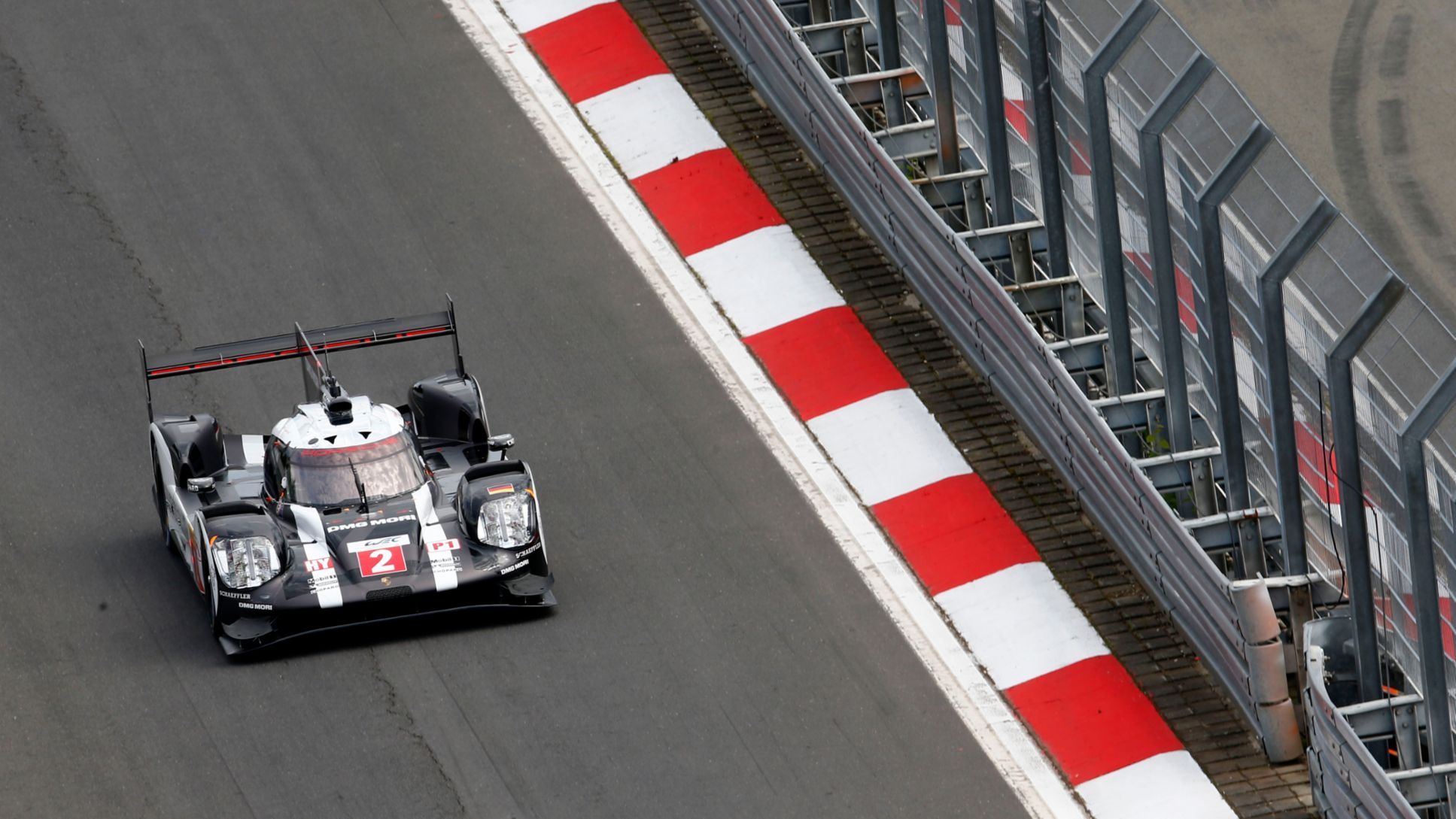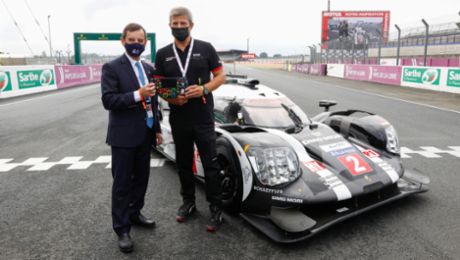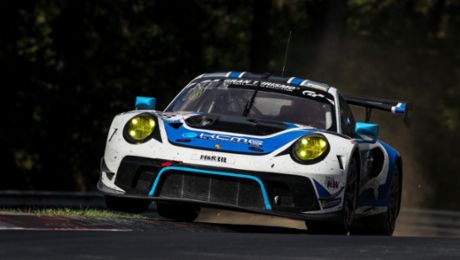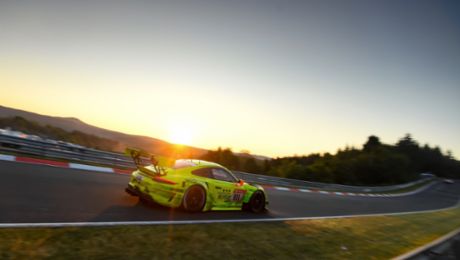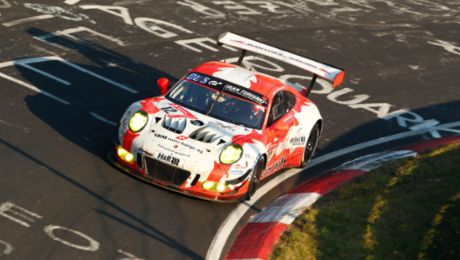Mixed start to the weekend for championship leader and title defender Porsche at the Nürburgring: Mark Webber (AU) achieved the overall fastest time of the day with a lap of 1:40.997 minutes. At the same time Romain Dumas (FR) went off the track because of a brake disc failure.
In bright sunshine, the reigning world champions and last year’s Nürburgring winners, Timo Bernhard (DE), Brendon Hartley (NZ) and Mark Webber (AU), came second and first respectively in the two 90-minute practice sessions. Romain Dumas (FR), Neel Jani (CH) and Marc Lieb (DE) with the sister car were fastest overall in the first session on the 5.148 kilometre long Grand Prix circuit, but dropped to fifth place in the second session because of the early stop.
Set-up work on the Porsche 919 Hybrid as planned
Team Principal Andreas Seidl: “The new aero package worked as we expected here at the Nürburgring so far and passed its performance test. All the drivers are happy with the balance of the cars. We have made another step forward, but our competitors also worked hard and were very competitive with close results. We did the set-up work on the number 1 Porsche 919 Hybrid as planned. Car number 2 had a failure of the front left brake disc during the second free practice that lead to an impact with a tyre wall. The damage to the car is minor and driver Romain Dumas was uninjured, which is the most important point. Let’s hope the weather stays nice and dry, but the forecast shows a lot of possibilities at the moment.”
Le Mans winner mounts title defence
As it heads into the six-hour race the Porsche Team is leading the manufacturers’ championship ahead of Audi and Toyota. The Le Mans winning drivers, Romain Dumas (FR), Neel Jani (CH) and Marc Lieb (DE), are leading the drivers’ world championship. The crew of the sister Porsche 919 Hybrid, Timo Bernhard (DE), Brendon Hartley (NZ) and Mark Webber (AU), has three unlucky races behind it and is more than keen to repeat last year’s race win at the Nürburgring.
A field of 33 race cars will compete in the Eifel. Prototypes and sports cars are divided into four classes, with the 919 Hybrid belonging to the top class for Le Mans Prototypes (LMP1). The 919 was developed in Weissach and produces a system power of over 662 kW (900 HP). Its combustion engine is a futuristic downsizing motor: the very compact two-litre V4 turbocharged petrol engine drives the rear axle with almost 368 kW (500 HP). Two different energy recovery systems – brake energy from the front and exhaust energy – feed a lithium ion battery that, on command, passes on the energy to an E machine to power the front axle with an extra boost of over 294 kW (400 HP).
Working flat out to further improve the 919 Hybrid
“We have had intense weeks since the breathtaking finish in Le Mans,” said Fritz Enzinger, Vice President LMP1, “with lots of appointments and events for the drivers. For example, the Goodwood Festival of Speed and the new Porsche Panamera’s world debut. Right after winning Le Mans Romain Dumas flew straight to the United States and went on to win the famous Pikes Peak hill climb in Colorado. At the same time, we were working flat out in Weissach to further improve the Porsche 919 Hybrid. Our target for the remaining six rounds is clear: We want to defend our titles in both the manufacturers’ and the drivers’ world championships.”
Team Principal Andreas Seidl pointed out: “Even during the intense time before and during Le Mans, the Weissach based development team was relentlessly working and finalised this year’s third aerodynamic package for high downforce. After a convincing four-day test in Barcelona, we have decided to run it at the Nürburgring. The data from the test, as well as the feedback from Romain Dumas, Marc Lieb, Brendon Hartley and Mark Webber, was promising. The majority of the modifications are covered by the bodywork, while the new look of the car’s front is obvious. We are well aware of the strong competition and ready to attack.”
In the WEC three aero configurations per season may be homologated. Porsche started the season with the first spec, the second one was for low drag on the long straights of Le Mans. For now, with narrower circuits coming up, again a higher downforce level is required.
Facts and figures
-
The six-hour race at the Nürburgring is the fourth round of the 2016 WEC and starts on July 24 at 13:00 hrs CEST.
-
Back in 2015, Dumas/Lieb took pole position with an average lap time of 1:36.473 minutes. The fastest overall qualifying lap was done by Marc Lieb (1:36.192 min). Bernhard/Webber managed an average time of 1:36.542 min and were second on the grid. (In the WEC the average of the respective best laps of two drivers counts for the grid position.)
-
Bernhard/Hartley/Webber won the 2015 race at ambient temperatures of over 30 degrees Celsius. Dumas/Jani/Lieb finished second after having been robbed of the lead by three long stop-and-go penalties during the first half of the race. While catching up, Jani stayed behind the wheel for 76 laps and set the fastest lap of the race (1:37.955 min).
-
In 2015 the WEC race weekend had a good crowd of 62,000 spectators. For 2016 the entry fee has remained the same: The weekend ticket is available in pre-sale for 35 Euros and, again, includes access to all open grandstands and the paddock, as well as the pit walk. A ticket for race day is only 30 Euros.
-
Porsche and endurance racing at the Nürburgring is a story of success. The so-called 1000 kilometre race has taken place 47 times between 1953 and 2014. A total of 12 overall wins make Porsche the most successful brand – the first victory dates back to 1967, the latest one to 2010.
-
At the Nürburgring 24-Hours on the Nordschleife Porsche has scored 11 overall wins and ranks second behind BMW (19). Among the current LMP1 Porsche works drivers Timo Bernhard has taken the winner’s laurels five times, Romain Dumas and Marc Lieb four times each.
-
On the 20.6 kilometre long Nordschleife the Porsche 918 Spyder holds the record for road legal sports cars. Marc Lieb was at the wheel in September 2013 and it took him six minutes and 57 seconds to secure that record.
-
A lap on the track used by the WEC is 5.148 km long.
-
At normal race speed (no safety car) the Porsche 919 Hybrid is due for refuelling after every 33 laps.
-
Refuelling and changing tyres may only be made sequentially, not at the same time. Only four mechanics may work simultaneously when changing tyres and may use only one wheel gun. That takes a lot longer than in Formula One, for example.
-
The drivers are normally only changed when new tyres are needed.
-
A set of Michelin slick tyres should last two fuel tank fills.
-
The WEC efficiency regulations limit the amount of energy that can be used per lap. At the Nürburgring the Porsche 919 Hybrid can use 4.68 megajoule of electrical power from energy recovery systems and 1.317 kilograms or 1.803 litres of petrol.
-
These different types of tyres can be used: three different compounds of slick tyres for dry conditions, a hybrid tyre (no profile either but softer cover) for mixed conditions and wet weather tyres. 6.5 sets of dry weather tyres are available per car for qualifying and the race.
-
After three out of nine rounds, Porsche leads the manufacturers’ standings with 127 points ahead of Audi (95) and Toyota (79). In the drivers’ world championship Dumas/Jani/Lieb are leading with 94 points in total and an advantage of 39 points. Bernhard/Hartley/Webber have only scored 3.5 points yet and rank 19th.
Quotes after Free Practice:
Drivers Porsche 919 Hybrid number 1
Timo Bernhard (35, Germany): “I grew up about 150 kilometres from the Nürburgring and I have a lot of nice memories from this track, including last year’s WEC victory here. It is great to take our fast prototype out on this track. Over the distance it is also pretty hard work, because this circuit doesn’t give you a chance to relax. The new high downforce aero package feels good, so we are pleased with day one.”
Brendon Hartley (26, New Zealand): “We have had two good sessions and both were dry, which wasn’t really expected. We have made lots of small changes and lots of small steps in the right direction. Our car is very good. Looking at the lap times, it is going to be a tight battle.”
Mark Webber (39, Australia): “We can’t read too much into today’s lap times, as it is race conditions that count. But we got the maximum out of today and the most information we could. The Nürburgring is fantastic for these fast cars, and we we’re happy to see the sun all day. Car number 1 is in good shape and we’re looking forward to qualifying tomorrow.”
Drivers Porsche 919 Hybrid number 2
Romain Dumas (38, France): “In free practice two suddenly the front left brake disc failed and I went straight into the barriers. The car is slightly damaged, but I’m okay. Unfortunately we couldn’t proceed with the set-up and tyre comparison work, but at least the 919 was great until the incident.”
Neel Jani (32, Switzerland): “Today wasn’t that great for us. During the first practice session the track was very dirty, then we lost time due to a red flag in FP1 and now because of the accident. Tomorrow we’ll try to make up for it.”
Marc Lieb (36, Ludwigsburg): “The general balance of the car and the new aero-kit was quite good from the beginning. Unfortunately the in-depth preparation was interrupted by the accident, but the main thing is that Romain is fine.”
Info
TV channel Eurosport 2 (pay TV) will broadcast on race day from 18:00-19:15 CEST and do a summary on July 27 from 09:30-10:00 hrs.
The live feed over the entire six hours, including live timing and further information, is available on the FIA WEC App. The basic version of the App is free of charge with a fee required for the live feed.
